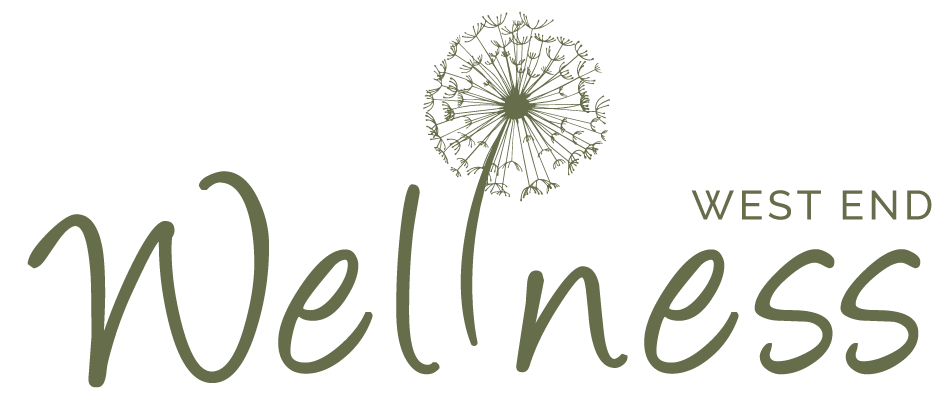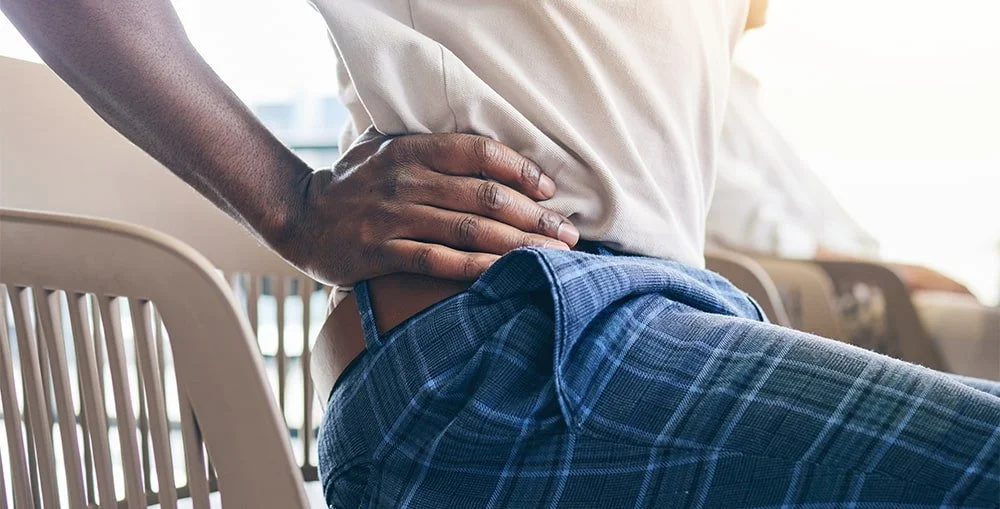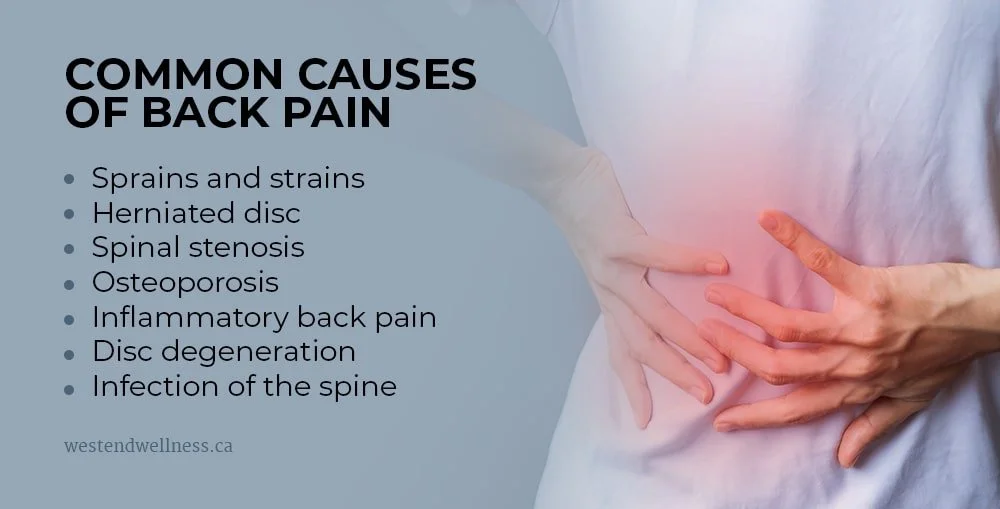What’s the Best Type of Massage for Lower Back Pain?
Table of Contents Show
Quick Summary
What's the best massage for lower back pain, and how can it transform your daily life? This comprehensive guide explores the world of massage therapy for back discomfort, unveiling five effective techniques tailored to alleviate pain.
Discover the causes of back issues and learn how to choose the right massage for your needs. We'll debunk myths about massage pain, provide quick relief tips, and explain why communication with your therapist is crucial. Uncover how the power of touch could be your key to a pain-free, more comfortable existence.
Lower back pain is a pervasive issue that doesn't discriminate.
It affects people from all walks of life - from office workers hunched over desks to active individuals pushing their physical limits.
At West End Wellness, we frequently hear from clients about the constant discomfort, the limitations on daily activities, and the frustration of finding effective relief for their lower back pain.
This common condition is more than just a minor inconvenience; it's a significant problem that can severely impact your quality of life.
Whether it's the sharp twinge when you bend to tie your shoes or the persistent ache that keeps you from enjoying your favourite activities, back pain can be a relentless companion.
This article presents massage therapy as a powerful tool in managing and alleviating lower back pain. We'll examine how various massage techniques can provide relief and improve your overall well-being.
Our discussion will cover:
The causes and impacts of lower back pain
How massage therapy works to alleviate back pain
The best types of massage for treating lower back pain
How to choose the right massage technique for your needs
Complementary strategies to enhance the benefits of massage
This information is valuable for those dealing with chronic back pain, individuals seeking alternatives to medication, and anyone interested in maintaining a healthy, pain-free back.
We know a lot about how massage therapy offers a natural, hands-on approach to tackling lower back pain.
However, by understanding the various techniques available and their specific benefits, you can make informed decisions about incorporating massage into your pain management strategy. Let's explore how massage can help you find relief and regain control over your back health.
Understanding Lower Back Pain
Lower back pain is a pervasive issue that affects people from all walks of life. Before we delve into how massage can help, it's crucial to understand the root causes of this common problem and how it impacts daily life.
By gaining this knowledge, you'll be better equipped to address your pain effectively and appreciate the benefits that massage therapy can offer.
Common Causes of Lower Back Pain
Lower back pain can stem from various factors, often interrelated:
-
Prolonged sitting or standing with improper alignment can strain the lower back muscles and ligaments. This is especially common among office workers who spend long hours at desks.
-
Sudden movements or lifting heavy objects incorrectly can lead to painful strains. These muscle knots or trigger points can cause persistent discomfort.
-
As we age, the discs between our vertebrae can wear down, causing pain and stiffness.
-
When the soft inner material of a spinal disc pushes through the tougher outer layer, it can irritate nearby nerves.
-
Various forms of arthritis can affect the lower back, causing pain and inflammation. Massage therapy has been shown to help manage arthritis symptoms.
-
Narrowing of the spinal canal can put pressure on nerves, resulting in pain.
-
Jobs involving repetitive motions, heavy lifting, or prolonged sitting can contribute to lower back pain.
How Lower Back Pain Affects Daily Life
The impact of lower back pain extends far beyond physical discomfort:
-
Pain can restrict movement, making simple tasks like bending or twisting difficult. This can significantly affect your ability to maintain a neutral spine position, which is crucial for overall back health.
-
Chronic pain can affect concentration and work performance, leading to decreased productivity and potential career setbacks.
-
Finding a comfortable sleeping position can be challenging, leading to poor sleep quality and further exacerbating pain.
-
Persistent pain can contribute to irritability, anxiety, and depression. Studies have shown a strong link between chronic pain and mental health issues.
-
Fear of pain often leads to avoiding exercise, which can further weaken back muscles and create a cycle of increasing pain and decreasing activity.
-
Chronic pain can interfere with social activities and relationships, potentially leading to isolation.
-
Medical treatments and potential loss of work hours can create financial stress, adding another layer of difficulty to managing back pain.
Understanding these causes and impacts is the first step in addressing lower back pain effectively.
In the next section, we'll discuss how massage therapy, particularly techniques like deep tissue massage, can help alleviate these issues and improve overall back health.
How Massage Therapy Helps with Lower Back Pain
Massage therapy has emerged as a powerful tool in the management of lower back pain. Its hands-on approach offers more than just momentary relief; it can provide lasting benefits that address both the symptoms and underlying causes of back pain.
General Benefits of Massage for Back Pain
Massage therapy offers several key benefits for those suffering from lower back pain:
Pain Reduction: Regular massage sessions can significantly decrease pain intensity. A study funded by the National Center for Complementary and Alternative Medicine found that almost 40% of participants reported that their moderate to severe back pain was nearly gone after 10 weeks of massage therapy.
Improved Flexibility: Massage helps to loosen tight muscles and increase the range of motion in the lower back and surrounding areas.
Stress Relief: Chronic pain often leads to increased stress levels. Massage therapy can help reduce stress and promote relaxation, which in turn can alleviate pain perception.
Better Sleep: By reducing pain and promoting relaxation, massage can improve sleep quality, which is crucial for overall health and pain management.
Enhanced Circulation: Massage improves blood flow to the affected areas, promoting healing and reducing inflammation.
Physiological Effects of Massage on Muscles and Tissues
The benefits of massage therapy are not just felt; they're rooted in physiological changes within the body:
Muscle Relaxation: Massage techniques, particularly deep tissue massage, help to release tension in the lower back muscles. This relaxation can alleviate pain caused by muscle spasms or tightness.
Fascia Release: Massage can help loosen and stretch the fascia, the connective tissue surrounding muscles. Tight fascia can contribute to pain and restricted movement.
Increased Endorphin Release: Massage stimulates the release of endorphins, the body's natural pain-relieving chemicals. This can lead to an immediate reduction in pain sensation.
Improved Lymphatic Flow: Massage can enhance lymphatic drainage, helping to reduce swelling and inflammation in the lower back area.
Trigger Point Therapy: Massage can help release knots in the muscles that may be contributing to pain by applying pressure to specific trigger points.
Neurological Effects: Massage can help to "reset" pain signals in the nervous system, potentially leading to long-term pain reduction.
Understanding these physiological effects helps explain why massage therapy can effectively treat lower back pain.
-
Your first visit will include a comprehensive health assessment. The acupuncturist will ask about your allergy symptoms, overall health, and lifestyle factors.
-
Acupoint Selection: Based on your specific symptoms and overall health, the acupuncturist will select appropriate acupuncture points.
Needle Insertion: Thin, sterile needles are gently inserted into selected points. Most patients report minimal discomfort.
Treatment Duration: Needles typically remain in place for 20-30 minutes while you relax.
Additional Techniques: Your acupuncturist may incorporate complementary techniques such as cupping or moxibustion, depending on your needs.
-
Common acupuncture points used for allergy relief include:
LI20: Located beside the nostrils, often used for nasal congestion
LI4: On the hand, between the thumb and index finger, used for various symptoms
ST36: Below the knee, known for its immune-boosting properties
-
For seasonal allergies, a typical treatment plan might include:
1-2 sessions per week during peak allergy season
A series of 6-12 treatments for optimal results
Maintenance sessions as needed
This article explores the unique benefits and differences between acupuncture and massage therapy, helping you determine which treatment best suits your needs.
Best Types of Massage for Lower Back Pain
At West End Wellness, certain massage techniques are particularly effective in treating lower back pain.
The following five types of massage have consistently provided relief for our clients. While other options may be available, these represent our most frequently recommended and utilized techniques for addressing lower back discomfort.
-
Sports massage targets muscle systems affected by specific activities, making it ideal for lower back pain caused by athletic pursuits or physical labor. It combines techniques to improve flexibility and prevent injuries.
Targets specific muscle groups affected by particular activities
Improves flexibility and range of motion
Helps prevent lower back injuries
Promotes faster recovery from intense physical activity
-
Therapeutic massage is a broad term encompassing various techniques tailored to address specific issues, including chronic lower back pain. It focuses on relieving pain and restoring function to problem areas.
Customized approach for individual pain patterns
Combines multiple techniques for comprehensive treatment
Aims to reduce pain and improve functionality
-
Myofascial release therapy focuses on manipulating the fascia, the connective tissue surrounding muscles, to alleviate lower back pain caused by fascial restrictions.
Releases tension in the fascia
Improves mobility and flexibility in the lower back
Reduces pain caused by fascial adhesions
Enhances overall posture and alignment
-
Swedish massage uses long, flowing strokes to promote relaxation and improve circulation, making it effective for mild to moderate lower back pain and tension.
Promotes overall relaxation
Improves blood flow to muscles
Reduces muscle tension in the lower back
Enhances flexibility and range of motion
-
Trigger point therapy focuses on applying pressure to specific points in muscles to relieve lower back pain caused by knots or areas of intense muscle tension.
Targets specific points of muscle tension
Alleviates referred pain patterns
Releases muscle knots in the lower back
Improves muscle function and mobility
Each of these massage types offers unique benefits for addressing lower back pain. The choice of technique often depends on the underlying cause of the pain, its severity, and individual preferences.
Choosing the Right Massage Technique for You
While we've highlighted five effective massage techniques for lower back pain, selecting the right one for your needs is crucial for optimal results. Here's how to make an informed decision:
Factors to Consider When Selecting a Massage Technique
Pain Level and Type: Mild to moderate pain may respond well to gentler techniques like Swedish massage. Chronic or severe pain might require more profound work, such as trigger point therapy. Sharp, localized pain could benefit from targeted approaches like myofascial release.
Personal Comfort: Consider your comfort with different levels of pressure and touch—some techniques, like sports massage, may be more intense than others.
Physical Condition: Your overall health and any existing medical conditions can influence the choice. Certain conditions may require specialized approaches.
Goals of Treatment: Swedish massage might be beneficial for relaxation and stress relief, while Sports massage could also improve athletes' performance. Therapeutic or trigger point massage might benefit chronic pain management.
Previous Massage Experience: If you're new to massage, starting with gentler techniques can help you acclimate. Experienced massage recipients might prefer more intensive techniques.
Importance of Communicating with Your Massage Therapist
Open and honest communication with your massage therapist is key to receiving the most effective treatment. Here's why it matters:
Customized Treatment: Your therapist can tailor the massage to your specific needs and preferences when you communicate clearly
Pain Management: Inform your therapist about your pain levels during the massage to ensure the pressure is appropriate
Addressing Concerns: Don't hesitate to voice any concerns or questions about the techniques being used
Feedback for Adjustment: Your feedback helps the therapist adjust their approach in real-time for maximum benefit
Tracking Progress: Regular communication allows you and your therapist to monitor improvements and adjust the treatment plan as needed
Remember, the most effective massage technique for lower back pain is one that you're comfortable with and that addresses your specific needs.
Don't hesitate to try different approaches or to discuss combining techniques with your massage therapist for optimal results.
FAQ about Massage for Lower Back Pain
Is it OK to push through back pain?
No, it's generally not recommended to push through back pain. Ignoring pain can lead to further injury or chronic issues. Instead:
Rest and modify activities that exacerbate the pain
Apply ice or heat as appropriate
Perform gentle stretches if they don't increase discomfort
Consider professional treatments like massage therapy to address the underlying cause
How can I loosen my lower back fast?
While there's no instant fix, you can help loosen your lower back quickly with these methods:
Gentle stretching exercises like cat-cow or child's pose
Using a foam roller or massage ball for self-massage
Taking a warm bath to relax muscles
Applying a heating pad to increase blood flow
Practicing gentle yoga or tai chi movements. Consider booking a professional massage session for more targeted relief for persistent tightness.
How do you know if back pain is muscle or disc?
While only a medical professional can diagnose the exact cause, here are some general differences:
Muscle pain:
It often feels like a dull ache or soreness
It may worsen with certain movements
It can be relieved by rest, gentle stretching, or massage
Disc pain:
Often feels sharp or shooting, possibly radiating to legs
It may worsen with sitting or bending forward
It can be accompanied by numbness or tingling
If you're unsure or experiencing severe pain, consult a healthcare provider for an accurate diagnosis.
Is it good if a back massage hurts?
A massage shouldn't be excruciating. While some discomfort can occur when working on tense or knotted muscles, it should be within your tolerance. Here's what to know:
Communicate with your therapist about pressure and pain levels
Some techniques, like deep tissue massage, may cause temporary discomfort
Pain should not persist after the massage
If a professional massage is consistently painful, it may not be the proper technique for you
Remember, the goal of massage is to relieve pain, not cause it. Always discuss any concerns with your massage therapist.
Conclusion
As we wrap up our exploration of massage therapy for lower back pain, we hope you've gained valuable insights into this effective, non-invasive treatment option.
With all our articles, we aim to inform you that you're now better equipped to consider massage therapy as part of your pain management strategy.
Let's recap the key points to remember:
Lower back pain can stem from various causes, including poor posture, muscle strain, and chronic conditions.
Massage therapy offers numerous benefits for back pain, including pain reduction, improved flexibility, and stress relief.
Different massage techniques, such as sports, therapeutic, and trigger point therapy, target lower back pain in unique ways.
Choosing the right massage technique depends on your pain level, personal comfort, and treatment goals.
Open communication with your massage therapist is crucial for achieving the best results.
Remember, taking control of your health is a powerful step towards improving your quality of life.
Massage therapy represents just one of many holistic approaches available to address lower back pain.
By exploring these natural, non-pharmaceutical options, you're opening doors to potentially life-changing treatments that work in harmony with your body's own healing processes.
Whether you're dealing with chronic discomfort or occasional flare-ups, don't hesitate to reach out to a qualified massage therapist.
Your journey towards a pain-free, more comfortable life could be just one session away. Embrace the possibility of relief and take that first step towards a healthier, happier you.
If you have any further doubts or questions regarding this subject or another treatment, contact one of our experienced Acupuncturists or Registered Massage Therapists here at West End Wellness Clinic. You can either give us a call or make an appointment.
Disclaimer: Please remember this article is for informational purposes only and should not replace professional medical advice. Please consult a healthcare provider or someone with the correct qualifications before starting any new exercise or treatment program.





